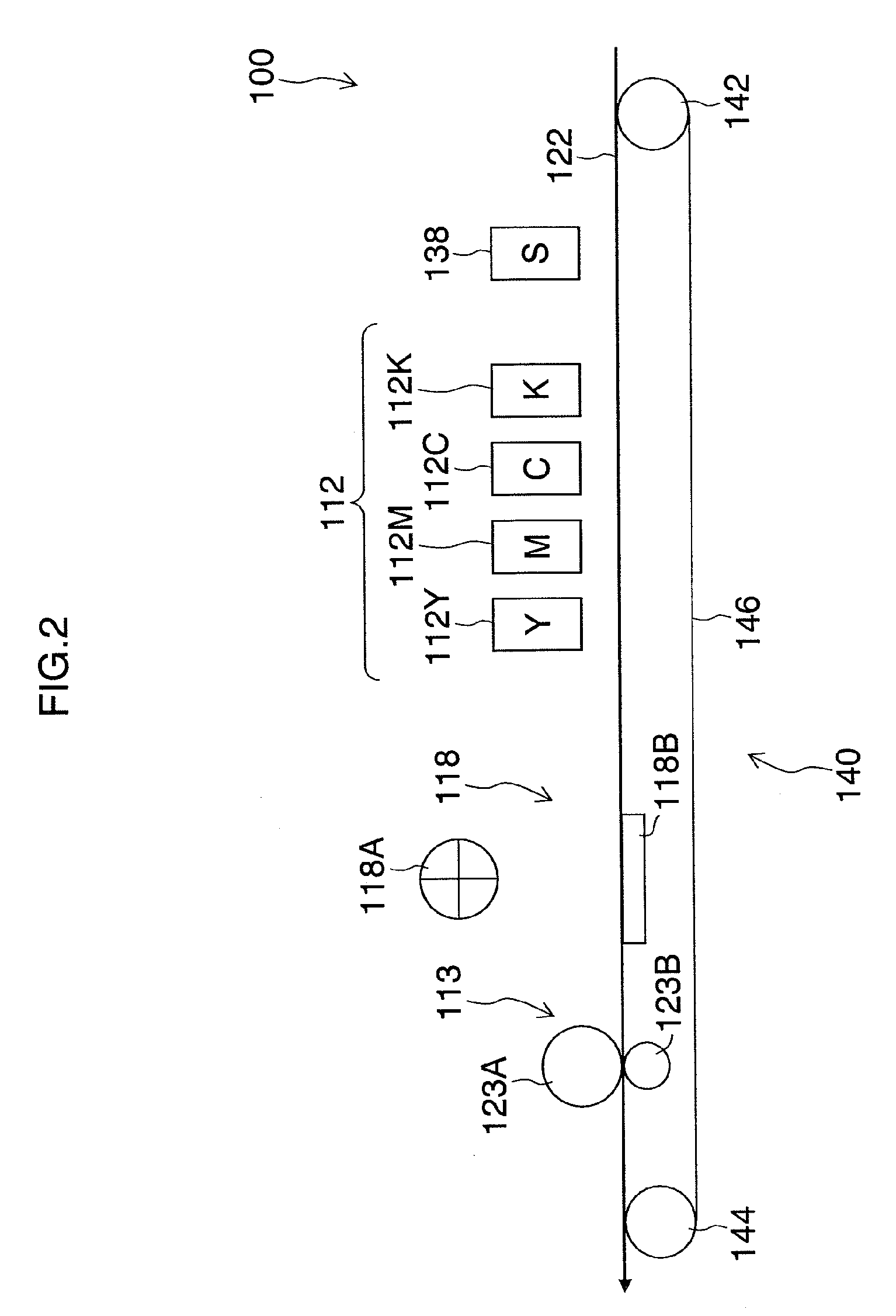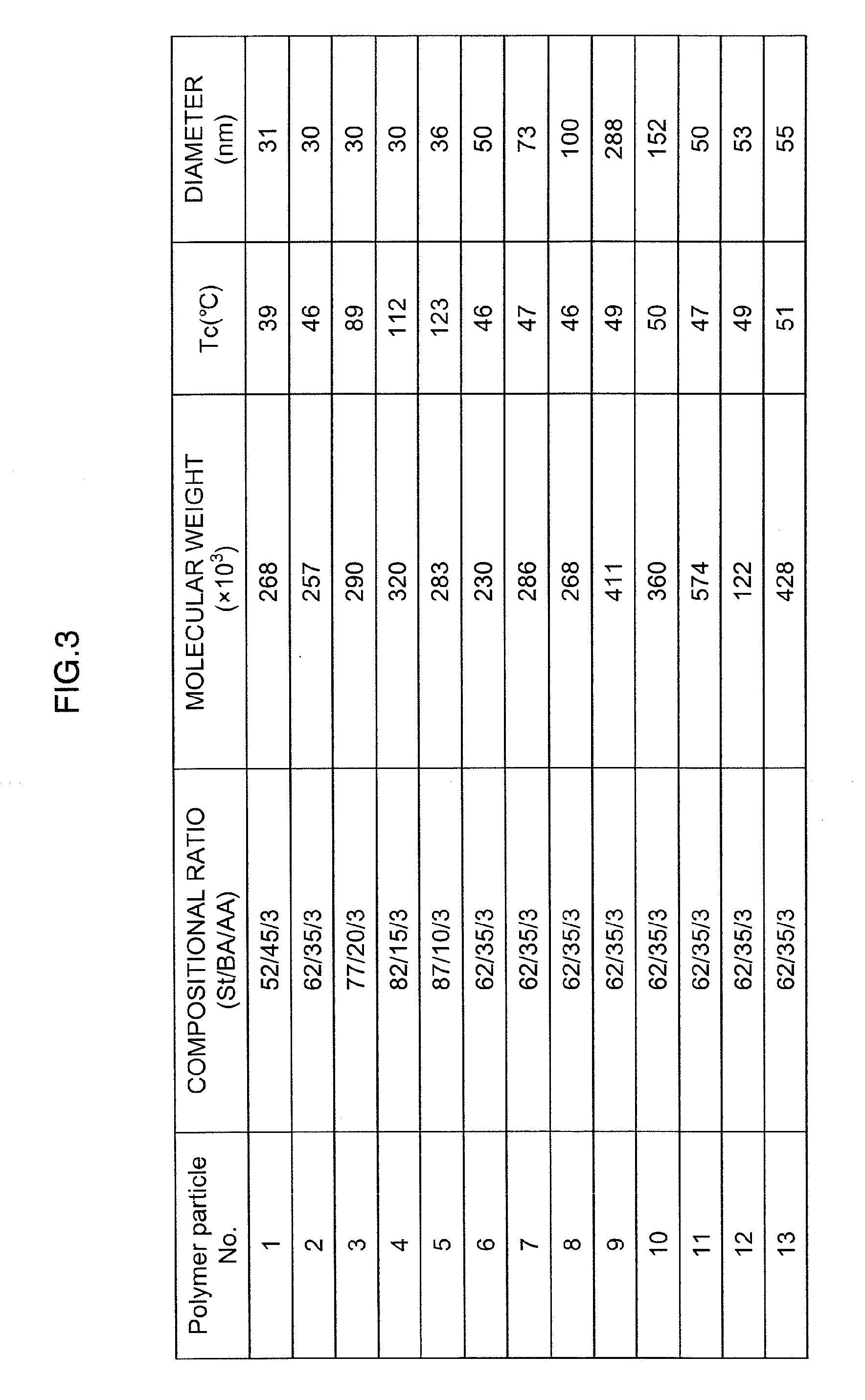Inkjet recording method
a recording method and technology of inkjet, applied in the direction of duplicating/marking methods, inks, coatings, etc., can solve the problems of insufficient fixing strength, large amount of water remaining inside the image structure, and difficult to obtain sufficient fixing strength, so as to prevent non-uniformity in image strength, strong image structure, and high density of particle layers
- Summary
- Abstract
- Description
- Claims
- Application Information
AI Technical Summary
Benefits of technology
Problems solved by technology
Method used
Image
Examples
first embodiment
[0084]Next, an inkjet recording apparatus for implementing the inkjet recording method according to the present invention will be described.
[0085]FIG. 1 is a diagram showing one example of the overall composition of an inkjet recording apparatus of a transfer type.
[0086]As shown in FIG. 1, the inkjet recording apparatus 10 principally comprises: an intermediate transfer body 12, a treatment liquid deposition unit 14, an ink ejection unit 16, and a transfer unit 18, and it is also provided with a solvent removal unit 20, a cleaning unit 22, and an image fixing unit 24.
[0087]The intermediate transfer body 12 is composed of an endless belt having a prescribed width, and the intermediate transfer body 12 is wound about a plurality of rollers 26. In the present embodiment, an example in which the four rollers 26A to 26D are used is described. The intermediate transfer body 12 is not limited to being an endless belt, and it may also employ a method where a cut-sheet intermediate transfer ...
second embodiment
[0121]Next, an inkjet recording method and apparatus of a direct recording type are described as a second embodiment.
[0122]FIG. 2 is a general schematic drawing of an inkjet recording apparatus of a direct recording type.
[0123]The image recording apparatus 100 shown in FIG. 2 employs a direct recording method in which an image is formed directly onto a recording medium 122.
[0124]The inkjet recording apparatus 100 comprises: a treatment liquid deposition unit 138 which deposits treatment liquid onto a recording medium 122; an ink ejection unit 112 comprising heads 112K, 112C, 112M and 112Y which eject droplets of inks of respective colors of K, C, M and Y onto the recording medium 122 on which a treatment liquid layer has been formed by depositing treatment liquid; a solvent removal unit 118 comprising a hot air supply apparatus 118A and a heating panel 118B which remove residual solvent component that is remaining on the recording medium 122 onto which droplets of the inks of respec...
examples
[0135]The present invention is described more specifically below with reference to practical examples, but the present invention is not limited to these examples.
Manufacture of the Pigment Dispersion Liquid
(Pigment Dispersion A)
[0136]A solution comprising 6 parts by weight of styrene, 11 parts by weight of stearyl methacrylate, 4 parts by weight of styrene macromer AS-6 (made by Toa Gosei), 5 parts by weight of “Premmer” PP-500 (made by NOF Corp.), 5 parts by weight of methacrylic acid, 0.05 parts by weight of 2-mercapto ethanol, and 24 parts by weight of methylethyl ketone was prepared in a reaction vessel.
[0137]On the other hand, a mixed solution was prepared by introducing, into a titration funnel, 14 parts by weight of styrene, 24 parts by weight of stearyl methacrylate, 9 parts by weight of styrene macromer AS-6 (made by Toa Gosei), 9 parts by weight of “Premmer” PP-500 (made by NOF Corp.), 10 parts by weight of methacrylic acid, 0.13 parts by weight of 2-mercapotoethanol, 56 p...
PUM
| Property | Measurement | Unit |
|---|---|---|
| Temperature | aaaaa | aaaaa |
| Temperature | aaaaa | aaaaa |
| Temperature | aaaaa | aaaaa |
Abstract
Description
Claims
Application Information
 Login to View More
Login to View More - R&D
- Intellectual Property
- Life Sciences
- Materials
- Tech Scout
- Unparalleled Data Quality
- Higher Quality Content
- 60% Fewer Hallucinations
Browse by: Latest US Patents, China's latest patents, Technical Efficacy Thesaurus, Application Domain, Technology Topic, Popular Technical Reports.
© 2025 PatSnap. All rights reserved.Legal|Privacy policy|Modern Slavery Act Transparency Statement|Sitemap|About US| Contact US: help@patsnap.com



